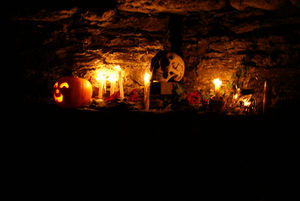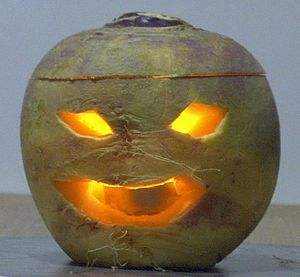Difference between revisions of "What are the origins of Halloween"
(Created page with "__NOTOC__ thumbnail|left|300px|Figure 1. A reconstruction of a Samhain offering. Halloween today is a fun holiday where kids and adults dr...") |
|||
| Line 2: | Line 2: | ||
[[File:4070363966 64412a1e5a b.jpg|thumbnail|left|300px|Figure 1. A reconstruction of a Samhain offering.]] | [[File:4070363966 64412a1e5a b.jpg|thumbnail|left|300px|Figure 1. A reconstruction of a Samhain offering.]] | ||
Halloween today is a fun holiday where kids and adults dress up and ask strangers and acquaintances for candy and (rarely) tricks. But what is the origin of this holiday? Like many other holidays, there were serious intentions in celebrations and cultural activities that took place at or around October 31st. It was seen as an important day that connected the dead, living and spiritual worlds in pre-Christian Europe. | Halloween today is a fun holiday where kids and adults dress up and ask strangers and acquaintances for candy and (rarely) tricks. But what is the origin of this holiday? Like many other holidays, there were serious intentions in celebrations and cultural activities that took place at or around October 31st. It was seen as an important day that connected the dead, living and spiritual worlds in pre-Christian Europe. | ||
| + | |||
====Early Origins==== | ====Early Origins==== | ||
Revision as of 19:30, 4 March 2018
Halloween today is a fun holiday where kids and adults dress up and ask strangers and acquaintances for candy and (rarely) tricks. But what is the origin of this holiday? Like many other holidays, there were serious intentions in celebrations and cultural activities that took place at or around October 31st. It was seen as an important day that connected the dead, living and spiritual worlds in pre-Christian Europe.
Early Origins
Like many of our holidays and traditions, the origins of Halloween connect back to pre-Christian periods, in this case most likely in Europe, although cultures in Asia and North Africa also had similar traditions. The name 'Halloween' derives from All Hallows' Eve, which is the day before All Saints Day (November 1). All Saints Day itself largely was intended to replace the Celtic festive of Samhain (Figure 1). In early, pre-Christian traditions, the time around Halloween was a time when the harvest was brought in and preparations for winter were made. The date of October 31 was traditionally a holiday for north European cultures as it marked the change of seasons when cattle were brought in from fields. It was also a time to remember the deceased, particularly as the days grew darker during that time of year and winter came closer. The time was seen as a spiritual preparation and wanting the deceased to given their blessing through the sacrificing of animals for meat and the harvest.[1]
The Celtic celebration of Samhain, and other cultures' celebration of the dead, often consisted of beliefs that the dead need to be made happy and even fed, since death brought no food or bad food. Food would be placed for the dead so that they could feast and be kept happy. The giving of food to dead could be the origin of giving food out in Halloween. Sacrifices were made to placate the gods but also the spirits that roamed the Earth. Because, by late October, more nighttime is evident, it was believed that this period afforded the opportunity for people to communicate with the dead. Darkness gave more opportunity for the spirits to roam while light was for the living and symbolized life.
The celebration of the dead and Samhain was to ask for help in the winter so that the living can make it through the tough months ahead. The dead could bring bad luck or make it difficult for the living. These traditions likely developed in the Neolithic or very early in the development of agriculture, as people began to depend on the harvest to get through the winters and remembering the dead became a way in which luck was given to the living.[2]
Later Traditions
While the Celts and other cultures, such as the Romans, had celebrations or events where they tried to ward spirits away from their homes, the Christian church did largely attempt to disassociate these old festivals by creating Christian ones that adopted similar themes. Pope Gregory in the 700s initiated the celebration of All Saints' Day and made November 1 as the date for the celebration. Earlier Christians had celebrated something similar in May but that was suppressed and the day was moved to November 1. In a way, this reflected how popular celebrations and remembering people who became saints, known and unknown, was not only important to newly converted people but incorporate those earlier northern European Celtic traditions of Samhain. This might mean the Church was interested in converting northern European cultures more in the 8th century and the movement of the date could have been to accommodate Samhain's previous importance to these cultures.
In fact, already in the 8th century, such as in the kingdom of Charlemagne, November 1st had primary significance in remembering the saints. November 2nd also began to be associated with All Souls' day, which celebrate those who had died. November 1-2, therefore, became days to remember the dead and saintly people who had departed. Traditions, such as lighting flame to remember the dead and passing out food to the dead, began to be incorporated with the Christian holidays, although their origin was pre-Christian.[3]
Halloween itself, October 31, began to be associated with the day before the November 1-2 celebrations associated with the dead and saints. It was intended as the preparation period for the celebrations. People often dressed in black or dark colors on October 31st as a way to begin to remember the dead, with celebrations beginning on the night of October 31st. This meant that people also started carrying lanterns to light their way through the streets (Figure 2). Myths and beliefs about the dead haunting this world and needing to be placated never went away either; this meant that lanterns needed to be scary so that they could scare the dead spirits.
In France, Spain and likely other regions, people visited cemeteries on Halloween bringing their lanterns so that they could feed the dead through gifts of food or milk placed by their gravestones. People began to associate earlier stories and beliefs of Samhain with October 31st as the day the dead would roam the Earth as well, thus the need to continue to placate the dead. In the 12th century, churches would sometimes ring their bells on Halloween day to remember the souls that are still in purgatory or were still roaming this Earth because they had not been judged yet.[4]
The tradition of dressing up may have begun when churches during the Medieval period began to encourage congregations to dress or wear relics of the dead and saints, although people may have worn in pre-Christian periods costumes to scare the dead away. In the Medieval period, costumes may have been a way to remember the dead without having to have the churches display all the needed relics for the dead. In effect, parishioners were made responsible to make sure the dead and saints were remembered by dressing as them. During the Reformation, many of the Catholic traditions were suppressed, including the celebrations of All Saints Day and Day of the Dead (All Souls Day). However, even then, people did often continue visiting graves or gather around graves on Halloween to remember their dead ancestors.[5]
Modern Celebrations
Mass Irish and other Catholic migrations to the United States and North America in the 19th century brought the traditions of Halloween not only to much of North America but soon it began to have an also celebratory feel in remembering the dead on Halloween. For some, it remained a solemn day with churches holding mass in graveyards on Halloween night to remember the dead. While lanterns, shaped into scary faces, dates to the Medieval period, people in the United States began to use pumpkins to make these lanterns. This is because turnips, which were traditionally used, were not as common in North American, thus pumpkins were used as substitutes. In the Medieval period, in England, children would go and ask for cakes that represented the souls of individuals. Children would then offer to pray for the souls of individuals. This likely was influenced by the earlier food giving traditions to the dead, but in North America it began to transform to a less solemn event in the form of trick-or-treating.[6]
Stories such as Frankenstein and Dracula, developed in the 19th century, and Legend of Sleepy Hollow began to be combined with the stories of Halloween. Haunted stories had existed for centuries, often associated with the dead haunting cemeteries, but these began to be combined as fun events or stories to tell children by the late 19th century, as people began to have more free time. The idea of haunted houses developed in the UK in the 1910s, but began to become more common as Halloween attractions in the 1930s in the United States. It was during the 1930s, trick-or-treating began to develop as a children-themed practice, although the association of children with trick-or-treating may derive from the cakes given to them in the Medieval period. Modern trick-or-treating was likely influenced by the Great Depression, as it was a diversion for children from the widespread poverty that occurred and candy was associated as something you give to children. Trick-or-treating also combined with the earlier tradition of wearing clothing to ward off spirits or remember the dead that derived from the Samhain and pre-Christian traditions.[7]
Conclusion
Halloween is a tradition that developed from pre-Christian traditions, particularly Samhain which was a day the dead were not only remembered but also feared because they also haunted places. It, however, did combine Christian traditions that began to blend some of the pre-Christian beliefs with Christian ideas, such as wearing costumes of saints or the dead. Halloween only became a fun celebratory day in the late 19th century and in the 1930s as it became a distraction from widespread poverty.
References
- ↑ For more on Samhain, see: Monaghan, Patricia. The Encyclopedia of Celtic Mythology and Folklore. New York: Infobase Pub., 2008, pg. 407
- ↑ For more on placating the dead, see: Kastenbaum, Robert, ed. Macmillan Encyclopedia of Death and Dying . New York: Macmillan Reference USA, 2003, pg. 426
- ↑ For more on All Saints and All Souls Day, see: Chambers, Catherine. All Saints, All Souls, and Halloween. A World of Holidays. Austin, Tex: Raintree Steck-Vaughn, 1997.
- ↑ For more on Medieval celebrations of Halloween, see: Cosman, Madeleine Pelner. Medieval Holidays and Festivals: A Calendar of Celebrations. New York: Scribner, 1981.
- ↑ For more on the Reformation and Halloween, see: Rogers, Nicholas. Halloween: From Pagan Ritual to Party Night. New York: Oxford University Press, 2003.
- ↑ For more on the shaping of Halloween traditions in North America, see: Santino, Jack, ed. Halloween and Other Festivals of Death and Life. Knoxville: University of Tennessee Press, 1994, pg. 152.
- ↑ For more on how Halloween developed in the 20th century, see: Morton, Lisa. Trick or Treat: A History of Halloween. First paperback edition. London: Reaktion Books, 2013.

